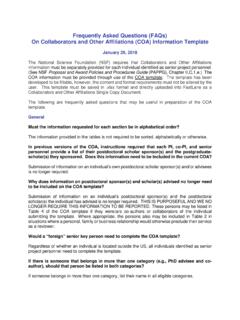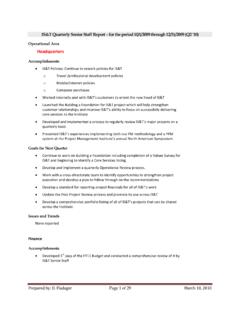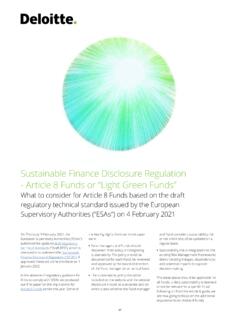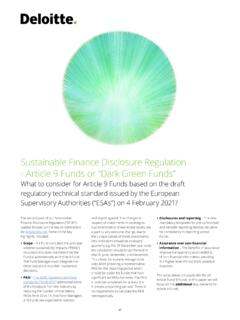Transcription of Management’s Response to Auditors’ Report
1 management s Response to auditors Report III-17 management s Response to auditors Report Attachment 1 management s Response to auditors Report management s Response to 05-01 Post-Award Monitoring management Comments on the Finding: NSF s post-award monitoring program is comprehensive and strong. Over the past four years in particular, management has invested significant resources in strengthening post-award monitoring. As discussed in management s Response to Exhibit II, management satisfied all four of the FY 04 post-award monitoring recommendations at a reportable condition level. The FY 05 post-award monitoring finding states that improvements are still needed and that in particular not all procedures specified in management s standard operating guidance for post-award monitoring were followed.
2 As discussed below, management did follow the procedures specified but has evidently failed to effectively communicate that to the auditors . This finding and the disparity between the auditors and management s basic understandings of procedures in place and actions taken demonstrates the importance of improving communications between NSF management , KPMG, and the Office of Inspector General. Independent Auditor Recommendation: Establish and implement a detailed strategic plan to monitor all institutions identified by the model as having high-risk awards. The plan should have specific procedures to monitor those institutions having high-risk awards that were not selected for site visits.
3 Also, NSF management should consider expanding the review procedures for the high-risk awardees to a level commensurate with their level of risk. NSF management Response : NSF management has established and implemented the BFA Post-award Monitoring Standing Operating Guidance (SOG) 2005-2, a comprehensive, integrated plan for post-award monitoring of all institutions including those that manage high-risk awards. The SOG includes the policies and procedures for all levels of monitoring: All NSF awards are subject to baseline monitoring. Policies and procedures for baseline monitoring are detailed under tabs 1, 2, 3, and 4 of the SOG.
4 Low and medium risk awards are subjected to Federal Cash Transaction Report reviews High-risk awards receive advanced monitoring. Policies and procedures for advanced monitoring are found under tabs 4 and 7 of the SOG. Independent Auditor Recommendation: Clearly state how site visits selections are to be determined. If not all high-risk awardees are to be visited, NSF should document its basis for excluding institutions with high-risk awards from a site visit review including a determination of the sufficiency of the number of awardees selected. In addition, revise the factors used to exclude institutions with high-risk awards from site visits to ensure that the factors used are appropriate considering the level of risk assessed.
5 NSF management Response : The selection process that results in the annual site visit plan is clearly described in the SOG under Tab 6, Risk Assessment Guide for Post-award Monitoring Site Visits, a component of the BFA Award Monitoring and Business Assistance Program (AMBAP). The Risk Assessment Guide applies to all NSF awards, excluding contracts and those awards specifically covered by the Facilities management III-18 management s Response to auditors Report and Oversight Guide. The Risk Assessment Guide contains the detailed policies and procedures for running the annual risk assessment process.
6 It is through the risk assessment process that we identify the high-risk awards, the first step in the development of the annual site visit plan. This multi-level, dynamic process resulted in NSF s FY 05 initial identification of 167 institutions as managing high-risk awards. At this same Tab 6 of the SOG, NSF management clearly documents the additional level of subjective review performed to eliminate organizations from the initially identified 167 universe that were: site reviewed through the Award Monitoring and Business Assistance Program the previous year; on the OIG audit plan or had OIG conducted audit reports issued within the last four years; subject to the policies and procedures of the Facilities management & Oversight Guide; or,had NSF awards due to expire in the current fiscal year.
7 To prioritize those organizations to be reviewed this fiscal year from the remaining 70 institutions we considered the following factors: A balanced portfolio by directorate and program; diversity of institution type; geographic location; overdue final project reports; issues with FCTR reporting; NSF oversight cognizance. This second level of review and analysis is how we determined the 25 institutions that we would site visit in FY2005. The following table demonstrates the process and rationale that was undertaken to make this determination. Number of Institutions Universe of Institutions Managing High-risk Awards 167 LESS Institutions that: Had BFA Site Visit in the Last 4 Years 31 Had OIG Audit or Report in the Last 4 Years 12 Had both a BFA Visit and OIG Audit Activity 5 Subtotal(48) Institutions with No Current Advanced Monitoring Activity 119 LESS: High-risk Awards Due to Expire during FY2005 (49) Institutions with No Current Advanced Monitoring Activity and Active Awards 70 LESS: Additional prioritization criteria (46) Planned Sites Selected for Visits during FY 2005 24 LESS.
8 Were on the FY2005 OIG Audit Plan (2) Final Site Selection22 PLUS: Sites Identified by: Program Request 4 BFA Concerns 2 LESS: Deferred Site Visits (3) Net BFA Adjustments 3 Actual Site Visits during FY 2005 25 III-19 management s Response to auditors Report In the Post-Award Monitoring finding, the auditors conclude, The 141 institutions that were not selected for site visits became subject to less monitoring than the medium and low risk awardees that are subject to being selected for FCTR transactional testing.
9 This statement is factually incorrect. In applying the risk analysis procedures outlined under Tab 6 of the SOG for fiscal year 2005, we identified 167 institutions managing high-risk awards. As the following table illustrates, of those 167 institutions or awardees, 99 also manage medium and low risk awards. The medium and low risk awards at those 99 institutions were subjected to the statistical sampling and transaction testing effort conducted under our contract with a Certified Public Accounting firm. The findings from that transactional testing provide information about systemic practices at the awardee institution that informs our monitoring of that institution s high-risk awards.
10 For example, transactional testing of a low or medium risk award can point to the awardee institution s misapplication of its indirect cost rate or the awardee institution s inclusion of expressly unallowable costs. The discovery of indications of an unacceptable systemic practice is considered by NSF in its ongoing monitoring of any high-risk awards at that institution. This practice is consistent with NSF s post-award monitoring program. An additional 38 institutions were excluded from advanced monitoring, because they were subject to site visits from the IG or BFA in the past four years as specified in the SOG.

















